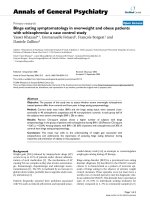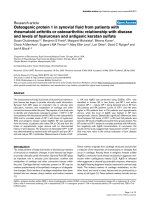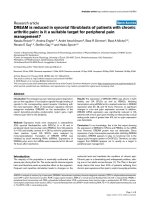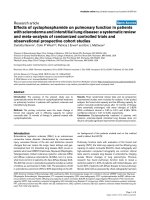Báo cáo y học: "Myocardial revascularization using on-pump beating heart among patients with left ventricular dysfunction" potx
Bạn đang xem bản rút gọn của tài liệu. Xem và tải ngay bản đầy đủ của tài liệu tại đây (502.68 KB, 6 trang )
RESEARC H ARTIC L E Open Access
Myocardial revascularization using on-pump
beating heart among patients with left
ventricular dysfunction
Ahmad K Darwazah
1*
, Vivian Bader
1
, Ismail Isleem
2
, Khalil Helwa
2
Abstract
Objectives: On-pump beating heart technique for myocardial revascularization has been used successfully among
both low and high risk patients. Its application among low ejection fraction patients is limited. The aim of our
study is to evaluate this technique among patients with low ejection fraction and to compa re results with off-
pump bypass technique.
Methods: This retrospective study includes 137 patients with ejection fraction below 0.35 who underwent isolated
coronary artery bypass surgery. 39 patients underwent myocardial revascularization usin g on-pump beating heart
(ONCAB/BH), while 98 patients had off-pump beating heart (OPCAB). Different preoperative, operative and
postoperative variables were evaluated among both groups.
Results: Patients profiles and risk factors were similar among both groups, except for the number of patients
undergoing redo CABG which was sig nificantly higher among ONCAB/BH (13% vs 3%; p = 0.025). Ejection fraction
(EF) varied from 10-3 4%. The mean EF for patients who underwent ONCAB/BH was 28 ± 6 in comparison to
26 ± 5 for OPCAB patients (P = 0.093). Predicted risk for surgery according to EuroSCORE was similar among both
groups (P = 0.443). The number of grafts performed per patient was significantly more among patients who
underwent ONCAB/BH (2.2 ± 0.7 Vs 1.7 ± 0.7; P = 0.002). Completeness of revascularization was significantly greater
in the ONCAB/BH patients (72% Vs 46%, P = 0.015). The incidence of hospital mortality and combined major
morbidity was more among ONCAB/BH in comparison to OPCAB, but the difference was not significant. However,
the incidence of blood loss, ventricular arrythmias, inotropic support, ICU, hospital stay and blood transfusion were
significantly greater among patients who underwent ONCAB/BH.
Conclusions: On-pump beating heart technique can be used in myocardial revascularization among patients with
left ventricular dysfunction. The technique was found to be associated with better myocardial revascularization
when compared with OPCAB technique. However, the incidence of morbidity and mortality was more than
OPCAB.
Introduction
Despite the presence of different pump techniques used
in surgical myocardial revascularization, the optimal
method used is still controversial. No technique was
found perfect to be applied to all patients. Nowadays we
are confronted with different categories of patients vary-
ing from straightforward low risk cases to complicated
ones due to the increase in number of el derly patients
with complicated coronary anatomy and impaired left
ventricular function.
The use of both conven tional cardiopulmonary bypass
and OPCAB among patients with impaired LVF proved
its efficiency and safety [1,2]. Under certain circum-
stances, the application of both techni ques could not be
possible and even harmful to the myocardium [3].
In our p resent work, ONCAB/BH tech nique was used
to revascularize the myocardium among patients with
impaired LVF. The results of such technique was com-
pared to those who underwent off-pump beating heart.
* Correspondence:
1
Department of Cardiac Surgery, Makassed Hospital, Jerusalem, Israel
Full list of author information is available at the end of the article
Darwazah et al. Journal of Cardiothoracic Surgery 2010, 5:109
/>© 2010 Darwazah et al; licensee BioMed Central Ltd. This is an Open Access article distributed under the terms of the Creative
Commons Attribution License ( which permi ts unrestricted use, distribution, and
reproduction in any medium, provided the original work is proper ly cited.
Patients and Methods
This study was performed retrospectively among 137
patients with isolated coronary artery bypass surgery
during the period from 1999-2009. The selection of
patients was based initially on their ejection fraction.
Those with ejection fraction below 0.35 were included
only and divided into two groups according to t he tech-
nique used during myocardial revas cularization. Ninety
eight patients underwent OPCAB, while thirty nine
patients had ONCAB/BH technique. Patients with com-
bined proced ure and those patients who initially under-
went off-pump and converted to on-pump beating heart
were excluded from the study. The decision to use
either technique was made intraoperatively based on
hemodynamic parameters.
Patients who could tolerate manipulation of the heart
without hemodynamic deterioration to visualise target
vessels underwent OPCAB revascularization. Those
patients who showed hemodynamic deterioration during
manipulation underwent ONCAB/BH.
Different preoperative, operative and postoperative
variables were eva luated among both groups. Analysis
was performed using statistical software version 13 SPSS
(Chicago, IL). Data are expressed as percentages and
compared using Fisher exact test. Variables are pre-
sented as mean ± standard error using student’sttest.
Statistical significance was assumed when P value was
less than 0.05.
Surgical Technique
Exposure of the heart was performed through median
sternotomy. F ull heparinization was used in all patients
maintaining activated clotting time >400 s. In patients
undergoing ONCAB/BH a s tandard cannulation of the
aorta and right atrium was used. A full cardiopulmonary
bypass with normothermia was used. Anastomosis of
the grafts to coronary arteries was initially performed
distally among all patients. Pr oximal anastomosis to
ascending aorta was performed immediately after finish-
ing each distal anastomosis. The sequence by which cor-
onary vessels were grafted varied from one patient to
another. Grafting of the LAD by left internal mammary
artery was the first to be performed. However, in some
patients with huge hearts, grafting of diagonal followed
by RCA and circumflex arteries was usually performed
first, leaving the LAD at the end to avoid stretching and
kinking of LIMA during rotation of the heart.
Anastomosis was facilitated by the use of both
U-shaped stabilizer (Guidant, Indianapolis, IN) and suc-
tion stabilizers (Medtronic Octopus III). Revasculariza-
tion of circumflex or obtuse marginal arteries was
performed with the help of Starfish apical positioning
device(Medtronic,Inc,Minneapolis,MN).Intracoron-
ary shunts (Medtronic Inc.) were used when needed.
Results
Preoperative patients profile and risk factors are listed in
table 1. There was no differences among both g roups,
except for the number of patients undergoing redo
CABG, which was significantly higher among ONCAB/
BH (13% Vs 3%, P = 0.025). Predicted risk for surgical
intervention according to EuroSCORE was similar
among both groups (P = 0.443).
Ejection fraction (EF) among all patients was below
0.35. It varied from 10-34. The mean EF for ONCAB/
BHwas28±6incomparisonto26±5forOPCAB
(P = 0.093). The incidence of main stem involvement
was more among ONCAB/BH patients, but the differ-
ence did not reach statistical significance (8% Vs 4%,
P = 0.765).
The extent of preoperative coronary artery disease was
similar among both groups regarding the involvement of
LAD, circumflex, second diagonal and o btuse marginal
coronary arteries. T he extent of righ t coronary artery
disease was significantly higher among OPCAB (70% Vs
51% P = 0.025). On the other hand, involvement of first
diagonal coronary artery was significantly higher among
ONCAB/BH (33% Vs 17%, P = 0.035). There was no dif-
ferenceregardingthenumberofcoronaryvessels
affected whether single, double or triple vessel among
both groups (P = 0.396).
There was a significant difference regarding the num-
ber of grafts used per patient among both groups
(Table 2). ONCAB/BH patients received 2.2 ± 0.7 grafts,
while OPCAB had 1.7 ± 0.7 (P = 0.002). The difference
was due to more grafting of the right and circumflex
coronary arteries.
Hospital mortality was slightly more among ONCAB/
BH patients, but the difference was not significant 8%
Vs 6%, P = 0.712(Table 3). The incidence of total major
morbidity was more among ONCAB/BH patients, but
the difference did n ot reach statistical significance (P =
0.778) . However, the incidence of blood loss, ventricular
arrythmias and inotropic support were significantly
greater among ONCAB/BH group. Transfusion of red
blood cells and its products were significantly greater
among ONCAB/BH, P = 0.001 (Figure 1). Postoperative
intensive care unit length of stay was significantly higher
in the ONCAB/BH patients(35 ± 20 hours vs27 ± 14
hours for OPCAB, P = 0.019). Similarly, postoperative
hospital stay was significantly higher in the ONCAB/B H
patients (7.1 ± 2.9 days Vs 5.9 ± 2.3 days for OPCAB,
P = 0.015).
Discussion
Conventional non-beating heart on-pump is still the
standard technique used in coronary artery surgery.
Complications in relation to this techniqu e are due to
the release of inflammatory mediators, the use of
Darwazah et al. Journal of Cardiothoracic Surgery 2010, 5:109
/>Page 2 of 6
cardioplegia, aortic cross clamping and hy pother mia [4].
Off-pump technique was introduced to avoid such com-
plications. Despite its effi ciency and safety over conven-
tional CPB, the technique was criticized by many
investigators regarding completeness of myocardial
revascularization, graft patency and long term r esults.
One of the important draw backs of this technique is
the hemodynamic deterioration which can occur during
manipulation of the heart during surgery, which entails
urgent transfer to conventional CPB. The results of such
surgery proved to be inferior [5].
From our previous study [1] using off-pump bypass
among low ejecti on fraction patients, we found that
such a technique is effective in reducing both mortality
and morbidity. Nevertheless, we agree with other
Table 1 Preoperative Demographics and Risk Factors
Variable On-pump BH (n = 39) Off-pump BH (n = 98) P value
Age 58 ± 8 57 ± 10 0.100
Female gender 7 (18%) 14 (14%) 0.826
BMI 27.6 ± 4.5 28.2 ± 4.5 0.564
Family History of CAD 19 (49%) 61 (62%) 0.128
Hypertension 17 (44%) 49 (50%) 0.354
Diabetes mellitus 18 (46%) 45 (46%) 0.929
Current smoker 22 (56%) 63 (64%) 0.362
Dyslipidemia 14 (36%) 41 (42%) 0.598
Obesity 12 (31%) 28 (27%) 0.778
Peripheral vascular disease 3 (8%) 8 (8%) 0.814
Carotid artery disease 5 (13%) 12 (12%) 0.387
Urgent operation 8 (21%) 28 (29%) 0.319
COPD 6 (15%) 15 (15%) 0.753
Redo CABG 5 (13%) 3 (3%) 0.025
Chronic Kidney Disease 6 (15%) 11 (11%) 0.126
Recent Angioplasty 6 (15%) 17 (17%) 0.884
Myocardial Infarction 26 (67%) 65 (66%) 0.600
Heart Failure 12 (31%) 52 (53%) 0.241
Unstable Angina 22 (56%) 43 (44%) 0.082
Stroke 5 (13%) 6 (6%) 0.381
Streptokinase 6 (15%) 5 (5%) 0.126
Clopidogrel 6 (15%) 8 (8%) 0.273
EuroSCORE 14.1 ± 11.0 12.2 ± 12.5 0.443
Table 2 Operative Data
Variable On-pump BH Off-pump BH P value
Use of LIMA 30(77%) 73(75%) 0.827
Use of RIMA 1(3%) 2(2%) 0.835
LAD Graft 37(95%) 95(97%) 0.544
RCA Graft 9(23%) 19(19%) 0.581
PDA Graft 4(10%) 4(5%) 0.019
D1 Graft 13(33%) 16(16%) 0.381
D2 graft 9(23%) 26(27%) 0.022
OM1 Graft 3(8%) 3(3%) 0.221
OM2 Graft 1(3%) 0(0%) 0.109
Cx Graft 7(18%) 4(4%) 0.182
Operation Time 4.0 ± 1.0 3.7 ± 1.0 0.033
Number of grafts 2.2 ± 0.7 1.7 ± 0.7 0.002
Complete revascularization 28(72%) 45(46%) 0.015
Table 3 Postoperative Morbidity and Mortality
Variable On-pump BH Off-pump BH P value
30-Day Mortality 3 (8%) 6 (6%) 0.712
Morbidity 12 (31%) 26 (27%) 0.778
Infection 4 (10%) 4 (4%) 0.765
Atrial Fibrillation 3 (8%) 8 (8%) 0.959
Ventricular Arrhythmias 9 (23%) 4 (4%) 0.002
Myocardial infarction 5 (13.15%) 8 (8%) 0.192
CVA 1 (3%) 1 (1%) 0.535
Respiratory Failure 3 (8%) 1 (1%) 0.133
Renal Failure 3 (8%) 3 (3%) 0.221
Intra Aortic Balloon pump 7 (18%) 10 (10%) 0.196
Inotropic Support 31 (79%) 29 (30%) 0.001
Estimated blood loss 974 ± 824 548 ± 337 0.001
Darwazah et al. Journal of Cardiothoracic Surgery 2010, 5:109
/>Page 3 of 6
investigators that the technique is not always associated
with complete revascularization. The main obstacle
which determines completeness of revascularization is
the hemodynamic deterioration which can occur during
such a procedure. To avoid such deterioration among
our patients, we advocated minimal manipulation during
surgery which obviously lead to less number of grafts
used and incomplete revascularization.
An interme diatory approach between conventional and
off-pump bypass was studied by Perrault and colleagues
[3]. They used on-pump beating heart ( ONCAB/BH)
among their patients with low ejection frac tion. They
found that using CPB without cross clamping and cardio-
plegic arrest with the heart beati ng is associated with less
myocardial oedema and ischemia . From the ir study, they
proved that such a technique is effective in preventing
myocardial injury and can be effectively used among high
risk patients who cannot tol erate cardioplegic arrest or
when the use of off-pump is not technically feasible.
Since the work of Perrault, various studies using
ONCAB/BH technique for myo cardial revasculariz ation
among both low and high risk patients was performed
[4,6-15].Thetechniqueprovedtobeareliableand
effective method and was associated with complete
revascularization.
The main idea of using ONCAB/BH technique among
high risk patients is to avoid the serious manipulation
which could be harmful to the myocardium and subse-
quently t o perform complete revascularization. Surpris-
ingly, in our study, we found that the incidence of
myocardial infarction was more among patients who
underwent ONCAB/BH when compared to OPCAB,
which indicates that manipulation of the heart even
when supported by the bypass machine is still harmful.
In an interesting study performed by Rastan and co-
workers[4] using ONCAB/BH among patients with nor-
mal ejection fraction, they found an increase incidence
of myo cardial injury when compared to off-pump.
Although, the effect was without any clinical significance
they believed that such a technique is not favourable to
off-pump bypass. Pegg and co-workers[12], confirmed
these findings, b y reporting that that the incidence of
new irreversible myocardial injury among patients with
impaired LVF was significantly higher among ONCAB/
BH patients when compared with conventional bypass.
The other bene fit of using ONCAB/BH is to ach ieve
complete revascularization. Previous studies showed that
this technique was associated with adequate number of
grafts performed among both low and high risk patients
[3,6,9,10,14,15]. Comparing the number of grafts per-
formed to other by pass techniques, conflicting results
were obtained. Some studies were in favour of off-pump
and conventional bypass over ONCAB/BH [4,7,14],
while others were in favour of ONCAB/BH when com-
pared to other techniques of bypass [9]. Prifti and col-
leagues in their study [11], found a similar number of
grafts performed among both conventional and
ONCAB/BH. We agree with previous studies that
ONCAB/BH technique is associated with adequate
number of gr afts performed. In our present stud y, there
was a significant difference in the number of grafts per-
formed and complete revasculariza tion was in favour of
ONCAB/BH. The main reason for such a difference was
due to difficulty in grafting of circumflex and posterior
descending coronary arteries among patients undergoing
off-pump bypass.
The mortality rate of patients with impaired LVF
undergoing ONCAB/BH varies from 2-8% [6,10,11,15].
Figure 1 Percentage of patients requiring blood transfusion and its products. RBC: Red blood cells, PLAT: Platelets, FFP: Fresh frozen
plasma.
Darwazah et al. Journal of Cardiothoracic Surgery 2010, 5:109
/>Page 4 of 6
The difference in mortality among various studies was
directly related to the difference in selection of patients.
Beside impaired LVF, other associa ted risk factors were
involved, as acute myocardial infarction, cardiogenic
shock and patients on dia lysis [7,8,15]. In our study, the
mortality rate was 7.7%, which was high compared to
other studies. The h igh mortality among our gro up of
patients wa s related to the impaired left v entricular
function. Other f actors contributing to the mortality of
patients were the preoperative association of heart fail-
ure and myocardial infarction, the failure to revascular-
ize both circumflex artery in 15% and RCA in 8% of
patients and lower percenta ge of patients who received
LIMA for grafting. Comparing our results with Folliguet
and colleagues study[6], they had t he lowest mortality
among their group of patients despite a similar mean
ejection fraction to our patients, we found that the
mean EuroSCORE of their patients was 5.8 ± 2.7 in
compariso n to 14.1 ± 11.0 among o ur patients. Th is
clearly shows the importance of associated other risk
factors affecting mortality beside impaired LVF.
There are limited studies evaluating the incidence o f
mortality in relation to using either ONCAB/BH or off-
pump. Among low risk patients, the mortality rate
among patients who had ONCAB/BH was higher than
off-pump bypass [9]. On the contrary, in Rastan and
colleagues study [4] the mortality rate was more among
off-pump bypass patients. In high risk groups, Edgerton
and colleagues [8] found that mortality rate was signifi-
cantly higher a mong ONCAB/BH patients when com-
pared to off-pump. Similar findings were seen in our
study. However, the differences in mortality among our
two groups of patients was not significant.
From the above limited studies, it seems that
ONCAB/BH is associated with more mortality t han
OPCAB despite the fact that these patients have ade-
quate myocardial revascularization. The explanation for
such unexpected results is related to the u se of bypass
machine. Early work by Perrault and co-workers [3]
found that the release o f inflammatory mediators inter-
leukin-6, interleukin-10 and elastase among patients
undergoing on-pump BH was not significantly different
from conventional bypass. A further study [13] found
that ONCAB/BH can trigger an intense inflammatory
response, they found that the levels of interleukin-6,
interleukin-8, interleukin-10 and tumour necrosis fac-
tor-alpha were significantly elevated when compared to
off-pump bypass.
It seems that ONCAB/BH techniqu e does not amelio-
rate the complications encountered with the use of
bypass machine and its effect among high risk patients.
This is the basic difference from off-pump bypass tech-
nique. In our study, the number of patients who had
postoperative major morbiditywerehigheramong
ONCAB/BH patients when compared to OPCAB techni-
que. The percentage of patients who had postoperative
renal failure, infarction, use of inotropic support and
IABP were less among off -pump patients. The amount
of blood loss and ventricular arrythmias were signifi-
cantly higher among ONCAB/BH patients. This was
reflected on the significant amount of blood transfusion,
blood products and longer ventilation time, intensive
care and hospital stay.
The application of ONCAB/BH among patients with
impaired LVF resulted in conflicting data. Although,
patients had significantly better myocardial revasculari-
zation, the incidence of mortality and morbidity was
more than OPCAB. It seems that ONCAB/BH techni-
que gives a false sense of security believing that the use
of by pass machine can protect the heart during manipu-
lation to perform a better revascularization. This could
be true among low risk patients, but the scen ario is dif-
ferent when the technique is applied to high risk group.
The present study is one of few studi es comparing two
technique used in myocardial revas cularization among
patients with impaired LVF. The study carries several lim-
itations, being a retrospective study among a small num-
ber o f p atients, which made the validity of the clinical
results limited. Further studies are needed in particular to
follow up these patients to find out the benefit which was
achieved by increasing myocardial revascularization
among patients who underwent on-pump beating heart.
In conclusion, we believe that ONCAB/BH can be
used in myocardial revascularization among patients
with left ventricular dysfunction. The technique was
found to be associated with better myocardial revascu-
larization, more morbidity and mortality when com-
pared to off-pump bypass.
Author details
1
Department of Cardiac Surgery, Makassed Hospital, Jerusalem, Israel.
2
Department of Cardiology, Makassed Hospital, Jerusalem, Israel.
Authors’ contributions
AKD Performed operations, conception and study design. VB Assist in
surgical procedures and acquisition of data. II and KH investigations and
follow up of patients. All were involved in interpretation of data and
statistical analysis. All authors read and approved the final manuscript.
Competing interests
The authors declare that they have no competing interests.
Received: 13 July 2010 Accepted: 10 November 2010
Published: 10 November 2010
References
1. Darwazah AK, Abu Sham’a RA, Hussein E, Hawari MH, Ismail H: Myocardial
revascularization in patients with low ejection fraction < or = 35%:
effect of pump technique on early morbidity and mortality. J Card Surg
2006, 21:22-27.
2. Youn YN, Chang BC, Hong YS, Kwak YL, Yoo KL: Early and mid-term
impacts of cardiopulmonary bypass on coronary artery bypass grafting
Darwazah et al. Journal of Cardiothoracic Surgery 2010, 5:109
/>Page 5 of 6
in patients with poor left ventricular dysfunction: a propensity score
analysis. Circ J 2007, 71:1387-1394.
3. Perrault LP, Menaschè P, Peynet J, Faris B, Bel A, de Chumaray T, Gatecel C,
Touchot B, Bloch G, Moalic JM: On-pump, Beating-Heart Coronary Artery
Operations in High-Risk Patients: An Acceptable Trade-off? Ann Thorac
Surg 1997, 64:1368-73.
4. Rastan AJ, Bittner HB, Gummert JF, Wather T, Schewick CV, Girdauskas E,
Mohr FW: On-pump beating heart versus off-pump coronary artery
bypass surgery-evidence of pump-induced myocardial injury. Eur J
Cardiothorac Surg 2005, 27:1057-1064.
5. Legare JF, Buth KJ, Hirsh GM: Conversion to on pump from OPCAB is
associated with increased mortality: results from a randomised
controlled trial. Eur J Cardiothorac Surg 2005, 27:296-301.
6. Folliguet TA, Philippe F, Larrazet F, Dibie A, Czitrom D, Le Bret E, Bachet J,
Laborde F: Beating heart revascularization with minimal extracorporal
circulation in patients with a poor ejection fraction. Heart Surg Forum
2002, 6(1):19-23.
7. Miyahara K, Matsuura A, Takemura H, Saito S, Sawaki S, Yoshioka T, Ito H:
On-pump beating-heart coronary artery bypass grafting after acute
myocardial infarction has lower mortality and morbidity. J Thorac
Cardiovasc Surg 2008, 135(3):521-6.
8. Edgerton JR, Herbert MA, Jones KK, Prince SL, Acuff T, Carter D, Dewey T,
Magee M, Mack M: On-pump Beating Heart Surgery offers an Alternative
for unstable patients undergoing coronary Artery Bypass grafting. Heart
Surg Forum 2004, 7(1):8-15.
9. Uva MS, Rodrigues V, Monteiro N, Pereira F, Bervens D, Caria R, Mesquita A,
Perdro A, Bau J, Matias F, Magalhaes MP: Coronary surgery: which method
to use? Rev Port Cardiol 2004, 23(4):517-30.
10. Gulcan O, Turkoz R, Turkoz A, Caliskan E, Sezgin AT: On-pump/beating-
heart myocardial protection for isolated or combined coronary artery
bypass grafting in patients with severe left ventricular dysfunction:
assessment of myocardial function and clinical outcome. Heart Surg
Forum 2005, 8(3):E189-82.
11. Prifti E, Bonacchi M, Giunt G, Frati G, Proietti P, leacche M, Salica A, Sani G,
Branaccio G: Does on-pump/beating - heart coronary artery bypass
grafting offer better outcome in end-stage coronary artery disease
patients? J Card Surg 2000, 15(6):403-10.
12. Pegg TJ, Selvanayegam JB, Francis JM, Karamitsos TD, Maunsell Z, Yu LM,
Neubauer S, Taggart DPA: Randomized Trial of on-pump Beating heart
and conventional cardiopelgic arrest in Coronary artery Bypass Surgery
patients with impaired left ventricular Function using cardiac Magnetic
Resonance Imaging and Biochemical Markers. Circulation 2008,
118:2130-2138.
13. Wan IY, Arifi AA, Wan S, Yip JH, Sihoe AD, Thung KH, Wong EM, Yim AP:
Beating heart revascualrization with without cardiopulmonary bypass:
evaluation of inflammatory response in a prospective randomised study.
J Thorac Cardiovasc Surg 2004, 127(6):1624-31.
14. Mizutani S, Matsuura A, Miyahara K, Eda T, Kawamura A, Yoshioka T,
Yoshida K: On-pump Beating-Heart Coronary artery Bypass: A propensity
Matched Analysis Ann Thorac Surg. 2007, 83(4)
:1368-1373.
15. Ferrari E, Stalder N, von Segesser LK: On-pump beating heart coronary
surgery for high risk patients requiring emergency multiple coronary
artery bypass grafting. J Cardiothorac Surg 2008, 3:38.
doi:10.1186/1749-8090-5-109
Cite this article as: Darwazah et al.: Myocardial revascularization using
on-pump beating heart among patients with left ventricular
dysfunction. Journal of Cardiothoracic Surgery 2010 5:109.
Submit your next manuscript to BioMed Central
and take full advantage of:
• Convenient online submission
• Thorough peer review
• No space constraints or color figure charges
• Immediate publication on acceptance
• Inclusion in PubMed, CAS, Scopus and Google Scholar
• Research which is freely available for redistribution
Submit your manuscript at
www.biomedcentral.com/submit
Darwazah et al. Journal of Cardiothoracic Surgery 2010, 5:109
/>Page 6 of 6









